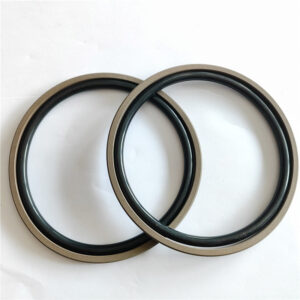Table of Contents
ToggleWhat is a Piston Seal?
A piston seal is a critical component in systems involving reciprocating motion, such as hydraulic/pneumatic cylinders, internal combustion engines, compressors, and actuators. It ensures efficient energy transfer by sealing the gap between the piston and cylinder bore, preventing fluid or gas leakage while maintaining pressure differentials. This article provides a comprehensive overview of piston seals, including their design, materials, applications, and selection criteria.


Definition and Core Function
A piston seal is a mechanical device installed in a precisely machined groove on a piston head. Its primary role is to create a dynamic barrier between the high-pressure and low-pressure sides of a cylinder, preventing hydraulic fluid, compressed air, or gases from bypassing the piston during operation. By maintaining this pressure differential, the seal enables controlled linear motion of the piston rod, converting fluid power into mechanical force.
Failure to use an effective piston seal can result in:
- Fluid leakage, reducing system efficiency and force output.
- Cylinder drift due to unintended pressure equalization.
- Contamination ingress, accelerating wear on internal components.
Key Design Features
Piston seals are engineered with specialized features to meet demanding operational conditions:
1. Dynamic Sealing Profiles
- U-Cup Seals: U-shaped elastomeric profiles (e.g., nitrile or polyurethane) ideal for moderate-pressure applications. Their design allows lips to flex under pressure, enhancing sealing efficiency.
- O-Ring-Energized Seals: Combine elastomeric O-rings with low-friction materials like PTFE (Turcon® Glyd Ring®). These excel in high-speed applications by minimizing stick-slip.
- PTFE Slide Rings: Thermoplastic seals with X-ring energizers for extreme pressures (up to 350 bar) and wide temperature ranges (–200°C to +260°C).
- Lip Seals: Incorporate spring-loaded lips (garter springs) to maintain consistent contact with the cylinder wall as wear occurs.
2. Anti-Extrusion Components
- Backup Rings: Made of thermoplastic or metal, these prevent soft sealing materials from deforming under high pressure.
- Integrated Guide Rings: Reduce side-loading and metal-to-metal contact, extending cylinder lifespan.
3. Single-Acting vs. Double-Acting Designs
- Single-Acting Seals: Used in systems where pressure is applied unidirectionally (e.g., return strokes assisted by springs).
- Double-Acting Seals: Handle bidirectional pressure, enabling powered extension and retraction in hydraulic/pneumatic cylinders.
Material Selection
Material choice directly impacts performance in specific environments:
| Material | Properties | Applications |
| Nitrile (NBR) | Oil-resistant, cost-effective, operates up to 100°C | General-purpose hydraulics |
| Polyurethane (PU) | High abrasion resistance, handles 300 bar pressures | Heavy machinery, construction equipment |
| Fluorocarbon (FKM) | Resistant to chemicals and temperatures up to 150°C | Automotive, aerospace, aggressive media |
| PTFE Composites | Low friction, inert to most chemicals, wide thermal range (–200°C to +260°C) | High-speed cylinders, food processing |
| Metal-Reinforced | Extreme pressure and temperature tolerance | Diesel engines, industrial compressors |
Applications Across Industries
Piston seals are indispensable in systems requiring precise motion control:
- Hydraulic Cylinders: Used in excavators, presses, and industrial automation to maintain fluid containment under 5,000+ PSI.
- Pneumatic Systems: Ensure airtight sealing in robotics, packaging lines, and material handling equipment.
- Automotive: Piston rings in engines contain combustion gases, while shock absorbers rely on seals for smooth damping.
- Aerospace: Actuators in landing gear and flight control systems demand lightweight, high-temperature seals.
- Energy Sector: Compressors and pumps in oil/gas operations use seals rated for corrosive fluids and extreme pressures.
Installation and Maintenance
Proper installation ensures longevity and performance:
- Groove Design: Follow ISO 7425 standards for depth, width, and surface finish to prevent extrusion and ensure optimal compression.
- Alignment: Misaligned seals can cause uneven wear or leakage.
- Lubrication: Apply compatible grease during assembly to reduce initial friction.
Maintenance Tips:
- Inspect seals periodically for cracks, hardening, or wear.
- Replace seals if leakage or pressure loss is detected.
- Avoid mixing incompatible fluids that degrade seal materials.
Failure Modes and Mitigation
Common causes of piston seal failure include:
- Thermal Degradation: Overheating softens elastomers or cracks PTFE.
- Chemical Attack: Incompatible fluids swell or corrode seal materials.
- Abrasive Wear: Contaminants in hydraulic fluid score cylinder walls.
- Improper Installation: Twisted seals or damaged grooves compromise sealing.
Solutions:
- Use wipers or scraper seals to exclude contaminants.
- Specify materials with higher temperature/chemical ratings.
- Incorporate filtration systems to maintain fluid cleanliness.
Selection Criteria
When choosing a piston seal, evaluate:
- Pressure Range: Ensure the seal profile and backup rings withstand peak system pressures.
- Temperature Limits: Match materials to operational thermal cycles.
- Fluid Compatibility: Verify chemical resistance using compatibility charts.
- Speed Requirements: Low-friction PTFE seals reduce heat generation in high-speed applications.
- Environmental Factors: Consider UV exposure, ozone, or abrasive particulates.
Conclusion
A piston seal is a precision-engineered component vital for converting fluid power into reliable mechanical motion. Its design—whether a simple U-cup or a multi-material composite—must align with operational demands like pressure, temperature, and media type. By understanding seal types, materials, and failure mechanisms, engineers can optimize system efficiency, reduce downtime, and extend equipment lifespan across industries.



Leave A Comment